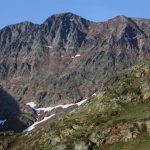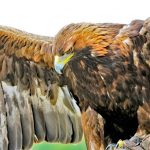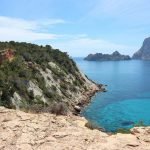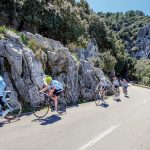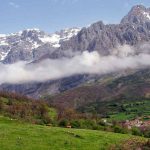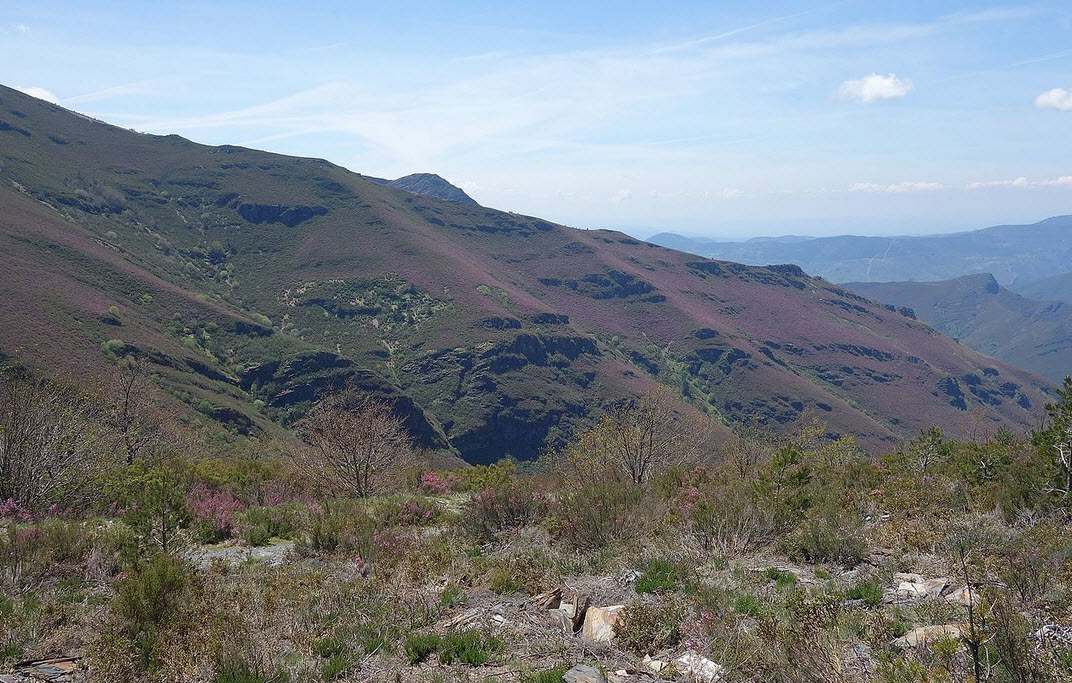Serra do Courel: Galicia’s Wild Frontier
The Serra do Courel is a place to come to without rush, to discover its ample modesty found in its flora and fauna, ancient villages hanging on by a thread, walking trails, river systems and its continuing, though disappearing, links to its traditional ways of work and living. Located south of the Pedrafita do Cebreiro pass connecting Galicia to the rest of Spain, the Serra de Courel range runs on a northeast-southwest axis creating a natural border and barrier separating Galicia from León.
From the north, one enters the Serra do Courel high along an open ridge. Looking south the range’s distinctive outline fills the skyline. Twisting roads along rounded, steep sided mountains separate you from the range and lead into the Courel’s heart. At first open, thick forest soon mitigates the views and each curve reveals a new facet of the Courel : rushing cascades, large handsome brown cows on the way to and from pasture, stone mills, centenary chestnuts. Canals chiseled into the hillsides, fed by year-round springs, water green pastures blanketing the plunging slopes. Spreading out around the range for 193 sq km, the Folgoso de Caurel township (Lugo province) contains some 45 villages hanging off of the hillsides and some few lie at river level. Today, roughly 1600 people populate the villages in contrast to 6957 inhabitants in a 1860 census.
The rounded, primarily slate, schistic and sandstone (interspersed with quartz) mountains (there’s an active slate mine in the heart of the Courel), rise to a modest maximum altitude of 1654m at Pico Formigueiros and then rush vertiginously downward to 400m at the valley floors cut through by numerous streams and three major river systems (Lor, Soldón and Quiroga). These rivers eventually drain into the Río Sil further south and water the Quiroga and Ribeira Sacra vineyards. Limestone deposits in seams and their effects on soil conditions, also enhance the area’s bio-diversity as well as account for Galicia’s largest concentration of caves complete with karstic stalagmites and stalachites. At 130m the Aradela cave, near the A Rogueira forest, is Galicia’s deepest explored cavern. Examples of some of Galicia’s 16 bat species take shelter in these caves and abandoned mines.
Due to the range’s NE-SW axis, its diverse soils, dizzying elevation changes, and the climate which has both strong Mediterranean and Atlantic influences, the Courel represents only 1% of Galicia’s surface area yet contains 40% (roughly 800) of the floral species identified in Galicia. This remarkable statistic means that a visit to the Courel is a must for any traveler searching for excellent examples of mixed woods relatively unaffected by incursions of invasive species (such as eucalyptus and pine commonly found in other parts of Galicia and Asturias), unusual and rare wildflowers as well as diverse shrubs. At lower elevations in the southern part of the Courel (eg, near Froxán) it’s possible to find more typically Mediterranean flora including cork oaks (Quercus suber), rock rose, arbutus or strawberry trees and aromatics such as thyme. Two types of woods are especially characteristic of the Courel : the devesa and the souto (which means chestnut grove).
The humid, north-facing forests of the Courel are called, devesas. Thriving on the steepest slopes, devesas have a distinct growth pattern of trees depending on the altitude, soil and exposition to the sun. Hazelnuts (Corylus avellana) branch out at all angles near watercourses and ravines. Evergreen holm oaks (Q. ilex), a Mediterranean species, are found by the occasional limestone outcrops while common and sessile oaks (Q. robur, Q. petraea) and beech (Fagus sylvatica) form the heart of the devesa on the shadiest, steepest slopes. Out of the steep slopes, the sun seeking beech rise towards the sky creating some L-shaped trunks. These beech are also among the Iberian Peninsula’s westernmost examples.
Three trees with red berries – the yew (Taxus baccata) (its berries are toxic!), rowan (Sorbus aucuparia), and holly (Ilex aquifolium)- join the oak and beech in the forest’s center. The holly trees provide significant winter shelter for some of the Courel’s 160 vertebrate (for example, mountain cat and marten) inhabitants whose branches provide a few degrees of extra warmth. Birch (Betula celtiberica) dominate at the highest altitudes while on the fringes of the devesa, where the steep slopes give way to gentler angles, Pyrenean oak (Q. pyrenaica) and rowan are found. Many of the 40 mammals dwelling in the Courel are found in the devesa or near its limits and include wild boar, hare, fox, wolf and, along the river banks, otters. Ten species of amphibians including Galicia’s three types of salamanders, the long-legged Iberian frog (Rana iberica), various snakes including the venomous Vipera seoanei, join approximately 100 species of birds including the highly endangered golden eagle (Aquila chrysaetos) and eagle owl (Bubo bubo).
Most important of the Courel’s devesas is the Devesa da Rogueira, accessed from the interpretative center in Moreda (open daily) beyond Seoane do Courel. Starting at 650m a hard 10km round-trip walk (from Moreda to the Fonte de Cervo and back) takes you up through the forest to the Courel’s highest ridge-line (1600m) passing through each of these distinct growing areas. Another easier (6km round-trip and less ascent) option which also gives great perspectives on the forest departs from the Alto do Couto.
Setting off from Moreda’s chestnut grove, the trail passes interpretative panels in Galego (the Galician language) which explain the traditional uses of various trees found throughout the forest. The trail winds through carefully hand-tended, green hay meadows (producing winter animal forage) and past wood and stone storage cabins (some in ruins) roofed with slate. As you ascend, the stately chestnuts give way to thick stretches of chaotic hazelnuts. Wild roses and blackberry brambles vie for the sunny, open areas hedging the trail. While ascending be on the lookout for, among many others, prickly butcher’s broom (Ruscus aculeatus) known locally as rasca cus (butt-scratcher), purple columbine (Aquilegia vulgaris), various members of the sweet pink family (light-pink Dianthus isofolium, white Stellaria vulgaris), the violet and white orchid Orchis morio, and the long stemmed, dainty blue Omphalodes nitida.
At one point early on, the trail opens and the barren ridge-line is visible ahead while the thick mass of the devesa neatly fills the huge north-facing bowl. It looks like a daunting ascent but once in the devesa, its enchantment takes over (and it’s just one foot in front of the other). The trail crosses several cascades and waterfalls where water shoots down across the path flanked with lush ferns and numerous small green plants including wild blueberries.
Nearing the ridge crest, where the trees notably thin and birch predominate, the trail reaches the Fonte do Cervo (the deer fountain). Especially spectacular in the spring time when more water flows, the natural spring gushes forth from two different fissures at the base of a steep, bush enshrouded cliff where lilac colored butterwort (Pinguicula lusitanica) thrive alongside the misty spring. What makes it curious is how distinct the two waters are – the water running through a limestone vein is sweet and delicious and the other, coming through an iron deposit, is distinctly metal tasting. This spring is the birthplace of the A Rogueira stream which you forded on the trip up and which later feeds into the Lor. During one hike in the devesa a local woman from Moreda told me the story of a man who had traveled the world looking for a solution to his health problems. He heard of the spring’s curative powers and trekked to the fountain to drink freely. Soon thereafter he was healed. Come and try it yourself !
The iron in the spring’s water provides the link to another Courel theme – it’s mineral wealth (primarily gold and iron). First exploited on the small scale for weapons and jewelry by the local inhabitants who lived in fortified settlements called castros (many vestiges of them mark the Courel landscape) dating from at least the Bronze Age (from the 7th century BC). Gold fever brought the Romans en masse to the area and their mines still remain etched in the landscape 2000 years later at La Toca and Torubio, both in the Courel (whose etymology – also written Caurel – derives from the Latin root for gold – aur). Great quantities of iron were used in the mining operations but despite that the iron reserves held out well after the gold disappeared and the Romans abandoned the area. Until the mid-19th century iron from the Courel supplied ironworks and foundries throughout the sierra as village names clearly indicate : Ferreirós de Abaixo, Ferrería Nova, Ferramulín or O Ferrería (in Galego ferro means iron). Many of the Courel’s old growth forests were destroyed at this time when wood was in high demand for the foundries and even household wood supplies were threatened. The Devesa da Rogueira can thank its particularly steep slopes for its salvation as they made the extraction of timber from the forest too costly and difficult.
Continuing past the fountain and working your way up past the tree line you discover that most of the Courel’s upper heights are open and covered with matorral (various types of Spanish broom, erica, tree heath, heather as well as the scratchy shrub Chamaespartium tridentatum). In June white and yellow broom and purple and white heather choke the trails and blanket the upper reaches in a dazzling show of color. Outstanding panoramic views are available from the ridge crest, topped by Picos Formigueiros, to other mountain ranges, such as the Serra dos Ancares to the north. Looking down the steep, often thickly wooded, slopes, Moreda, below in the valley floor, is a mere speck. Looking south-east the desolate, unassuming shrub-covered hillsides are home to one of the Courel’s most productive iron veins exploited during centuries. From here the words of the Courel-born poet Uxío Novoneyra (1930-1999, b. Parada de Moreda) are particularly apt : Courel dos tesos cumes que ollan de lonxe ! Eiquí síntese ben o pouco que é un home… (Courel of the immovable summits that look from the distant heights ! Here, one feels how insignificant man is…).
From the ridge it’s possible to continue following the open dirt road and loop back passing above Galicia’s only glacial lake – Lagoa da Lucenza. In late summer it usually dries though the reeds and rushes mark the humid zone. Up on the ridge you may also find clusters of yellow-throated purple toadflax (Linaria triornithophora) before heading back down through the devesa.
Romans may have taken the gold from the Courel but they left behind another valuable commodity : sweet chestnuts (Castanea sativa). Over time chestnuts and their products would become the Courel’s gold standard providing sustenance for both animals and humans, lumber, fuel and an exportable product fundamental to the Courel economy. Exploring the Courel you’ll notice that nearly every village is embraced by a huge communal grove. In the Meiraos and Seoane parishes there are some 20 sq km of groves. Each tree had an owner but the trees formed part of the village patrimony and were fundamental to the yearly cycle of life and work. Thriving at altitudes up to 900m, chestnuts are rich in carbohydrates and were the basic building block (along with pork) of the local diet until about 30 to 40 years ago. On a side note, the potato (brought from the New World in the 16th century) was actively cultivated in Galicia by the 18th century and slowly supplanted the chestnut in importance. In some areas of Galicia the potato is still known locally as ‘castaña de terra’ (earth chestnuts) highlighting the nut’s prime importance. Chestnuts were eaten fresh, boiled and mashed, used in stews and dehydrated in an elaborate 20-day process which allowed for their consumption all year long after the fall harvest. The dehydration took place in sequeiros, split-level structures located near the groves.
In the soutos the huge-trunked centenary trees are pruned in an eye-catching way. Rather than allowed to grow with one long-limbed trunk, as they would if left to themselves, the chestnuts are carefully pruned to produce numerous branches thereby increasing the productivity of each tree and also allowing for timbers to be cut for lumber without harming the tree. The low-trunked trees have at least six branches stemming off from the main trunk growing with roughly vertical offshoots.
In spring time the long yellow tassles (candea) of the male flowers paint the grove while the long oblong jagged-edged leaves, shade the forest floor. Slowly over the course of the summer the flower converts into a spiny and very prickly yellow-green case (in Spanish erizo, in Galego ourizo – both of which mean hedgehog). By fall the prickly case is dark brown and the forest is a kaleidoscope of yellow, ochre and tan. The chestnut casings pop open and the smooth, amber-brown hemispherical nuts (usually coming in threes from the case) drop to the ground. Chestnuts start producing flowers after 20 to 30 years.
It’s also possible to find a number of chestnut varieties valued either for the quality of their wood or fruit : Brava, Caurelá and de Presa varieties were known for their outstanding wood, while de Parede, Luguesa and Revolta were prized for their large, tasty nuts. The Rapada variety is easy to peel and was often boiled with milk while the Vilacha might produce up to ten little chestnuts within each shell.
Each year on the second weekend in November the villages of the Courel gather in either Folgoso or Seoane do Courel for a communal chestnut roast called a Magosto based on the tradition of families getting together on Todos los Santos, ie, Day of the Dead (November 1), to eat roasted chestnuts and drink the local wine. Particularly fine groves to lose yourself in are those of Vilar, Parada and Mercurín.
Travel tips:
A good way to wrap up a visit in the Courel is to stop by Bar Pontón located on the road between Folgoso and Seoane by a small river in Ferreirós de Abaixo for a drink or outstanding meal. The owner cum artist has managed to transform the remnants of the chestnut forest into masterpieces of practical and aesthetically very pleasing pieces of furniture.

